Only two days left in the competition and we’re second overall. There are not many opportunities left to make a play for the leading position and today looked like the best opportunity. The weather looked good, with high thermals promising a long soaring day and a long soaring task. This would lead to more points awarded for the day, and also possibly greater point spreads among the competition. The weather was most complicated by the presence of a cold front stalling in our area. This front was dry enough that it would create strong lift at its boundary and the task was designed for us to run along it toward Oklahoma.
Noah and I looked at each other and understood that the long game was over. No longer are we holding back, playing for consistency and maximizing the expected value of points over time. Today was the day to push and go for the win.
I was anxious. Timing was everything. We watched the front, trying to pinpoint when it would pass and how it would set up within the two turn sectors to the south and west of the airport respectively. Would it pass early, requiring an early start and a deep push south? Would it pass late, require a later start and stay to the north? How would the other contestants play the conditions? Should we be on the front end or the back end of the start? How are the conditions going to be on the front end or the back end of the front? On the front side, there will be a strong southerly headwind, but stronger thermals. On the back end, perhaps lower and bluer, but less wind. But then there’s the headwind at the end of the day and stronger sink along the way. So if the front moves faster, then we may have a lot of trouble getting back. But perhaps we can hook around the back of it, accepting a deviation over the lake? Besides, how is the front going to set up anyway? Theory suggests it looks like a wedge, but how will the clouds look? Will there be a step? How will we find it? What are the clouds doing upwind of us right now? Is that hazy layer northwest of us the front??
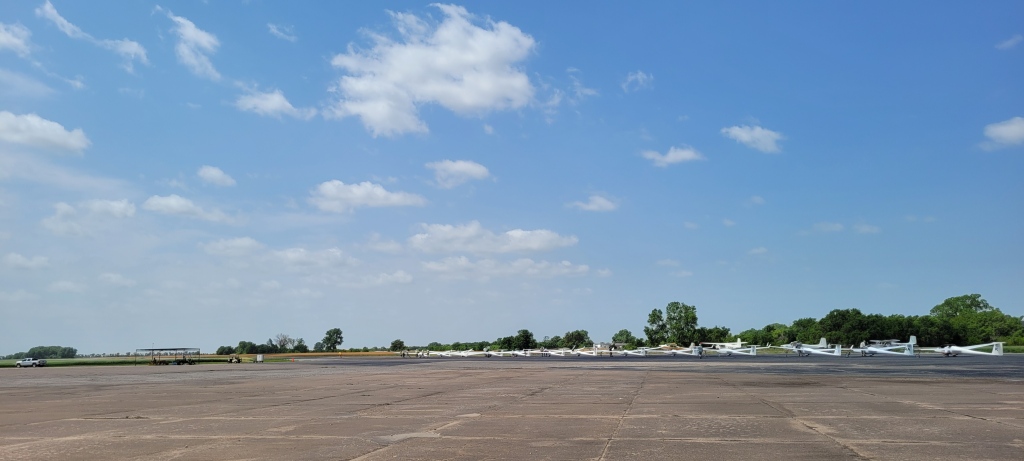
My thoughts kept going round and round in my head, with little resolution or recourse. Noah was somewhat bemused, watching as my eyes flitted about in an agitated state, trying to make sense of my stream of consciousness. He was right there with me, looking at the forecasts, and sort of resigned himself that we will just need to figure it out when we get up there. Having accumulated all the information I could, I accepted the range of uncertainty in the day, and we finally sketched out a couple scenarios for how we could play it. In all cases, we needed to drive hard and roll on our own. If we played the same flight as the others, today it would not do.
With an early grid, we got in the glider a little after noon, looking at a fairly stiff quartering headwind for takeoff and good looking cumulus clouds just above us. We released in good air all around, suggesting that the front had finally arrived. We climbed up, got in position with the other gliders and waited for the gun to go off to indicate the start was open.
We watched the Standards go quickly and figured that the 20m folks would do the same. Sure enough, just before 1pm, our class streamed out on course. We held our breath for a couple more minutes and took a more easterly route. This got us a little higher on the start and a straighter run under better looking clouds.
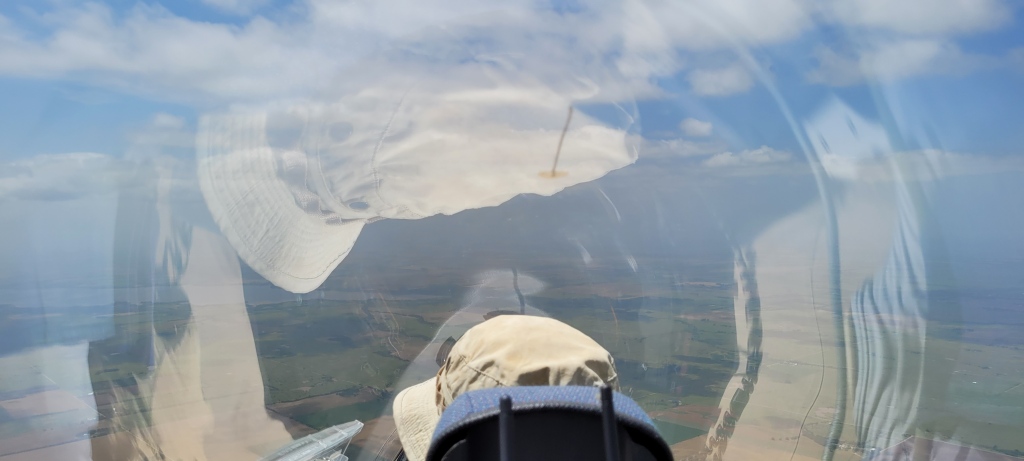
We stepped on the gas. It was like I had a little prod and I would poke Noah every couple minutes and repeat, 85-90 knots!
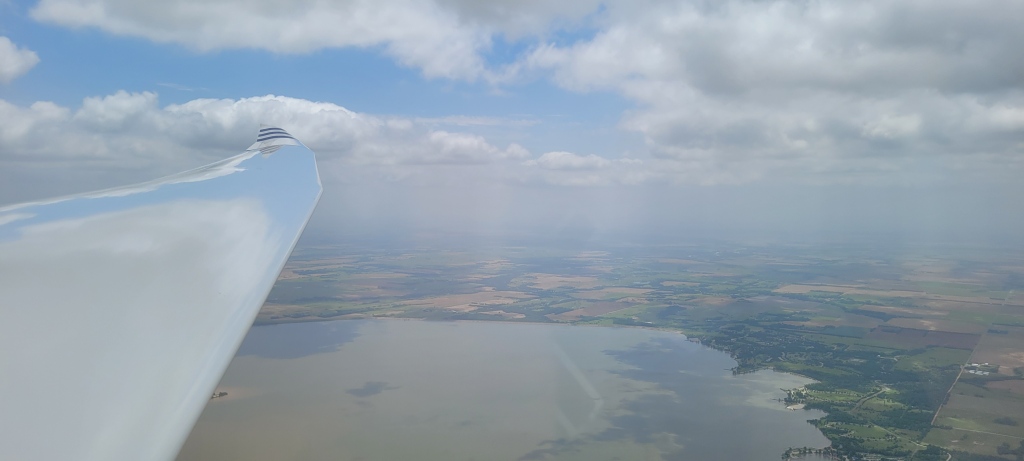
We were catching up to several Standards on the first leg, and were looking at many southwesterly streets lined up with the wind. We couldn’t quite figure out where the front was, or where the best place to go. We drove short of the middle of the first sector, and the clouds further to the south looked lower and less defined. We figured that this was a good place to turn and set up for the following leg.
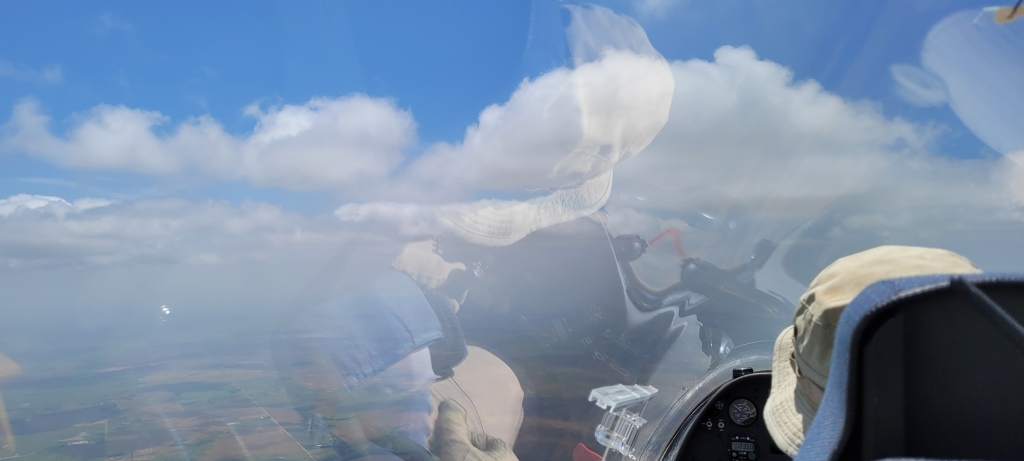
Noah was flying exceptionally well, right on the ball. We were loaded up with water ballast for extra weight to go faster, but he was cleaving this 70ft wide bird into the turns with little effort at all. The glider flew poetically, smooth, and gracefully. I always enjoyed watching him center the thermals; with a turn and a half the variometer was always humming a cheerful three to four knots around the turn.
I would keep an eye on course and watch for other gliders. As we would climb up, I would give a gentle nudge by suggesting maybe we could do better, and Ready. Despite being in the same glider, we still ended up using a fair amount of the standard team-flying lexicon for consistency.
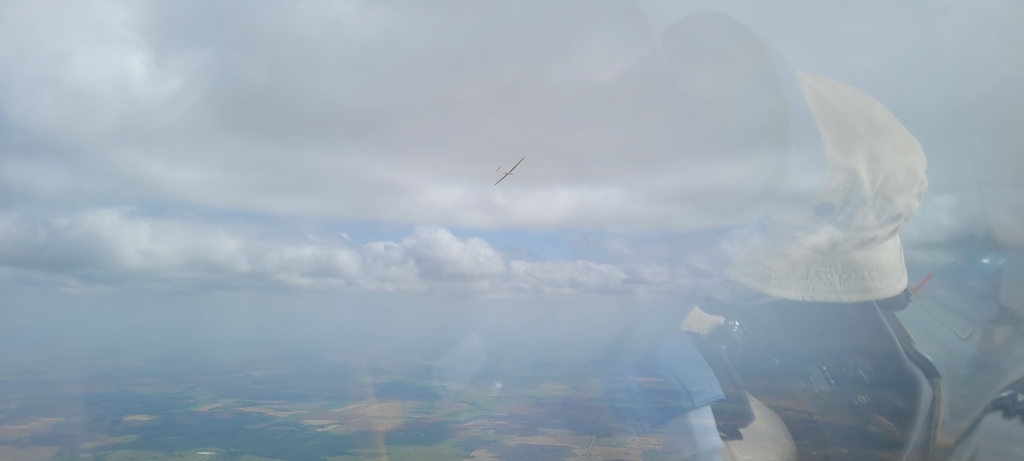
Noah would reply, Ready… Last turn!
And off we would go.
On the second leg, most of the decisions were collaborative. Left or Right?, we would ask each other. There were good thermals out there, but the lift band seemed to work best higher under the clouds. It seemed like every two or three minutes there was a big tactical decision to make in terms of where to go under the clouds, like tiptoeing over a minefield. We mostly managed to stay connected with the lift.
Crossing into Oklahoma, the thermals started to get somewhat farther apart and the clouds lost some of their definition. With a 20 knot headwind, we still had to keep the pressure on, though we started to get lower and into the trap. We finally found a 2.5 knot thermal at 3800ft and promptly parked there to reconnect with the higher lift. But then Phil Gaisford in Standard Class started turning about a half mile off of our right wing, going up like a banshee. We joined him and found a solid 5-6 knots! Thanks Phil! Ryszard and David Hart also joined us and we ended up in the same area for a fair amount of the remainder of the flight,
It was a big decision how far to go into the second sector. On the one hand, once we turn we would now have the tailwind and streeting on the way home, which would suggest that we would go a lot faster than when we were flailing ourselves against the 20 knot headwind. On the other hand, the front was likely to keep pushing southeast, further away from the airport. If we went too far and if we fell off the day, we would have to then struggle into even weaker and blue conditions late in the day. A couple minutes here or there could determine the contest, 170km away from home.
I pushed Noah to extend a little bit farther. There was another cloud ahead and we milked the good air on the upwind line. We ended up turning with ten minutes extra on the clock and then turned tail for the mighty race back to the finish.
We now found ourselves getting lower and lower. We really did not want to fall out of the band and were willing to take a long, slow climb. Besides, with the tailwind, a 2.5 knot thermal ain’t so bad anyway. But we struggled to connect, having difficulty finding the thermals under the broad cumulus clouds. As we ground our way up, the thermals seemed to get cut off at various altitudes, making it a struggle to get all the way up. But with every climb, we ended up higher than we started. And about halfway into the leg, we were up at cloudbase, making great time with the tailwind, good air under the clouds, and high true airspeed. We were making such good time that we were likely to come in under time at this rate.Might as well stay conservative now and stay connected with the good lift.
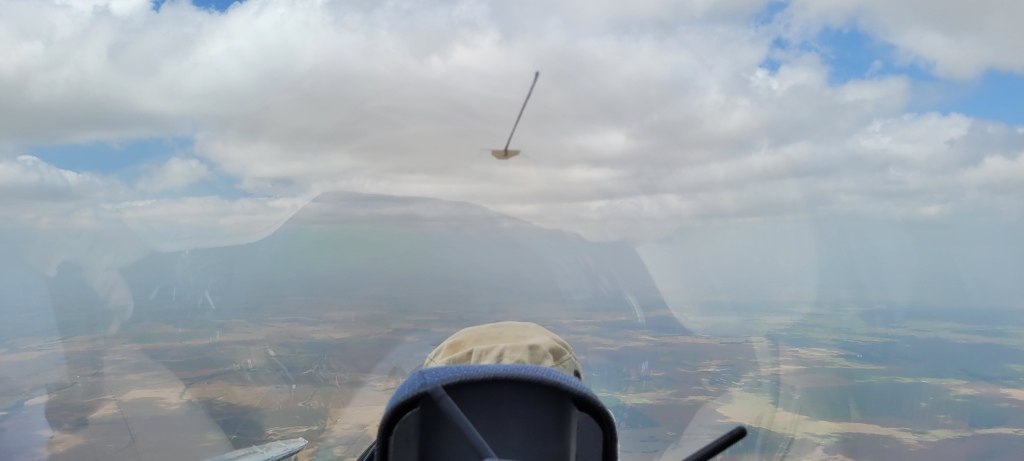
Coming close to home, we were worried about the final glide. We wanted to tank up and then some to account for the change in airmass. We got ourselves on a MC 3 glide, but we knew we needed extra. The thermals started tapering off and we down-shifted. But we did so a bit too late. We were now on the back end of the front and the variometer dropped. We were bleeding altitude and we could see the airport rising in front of us.
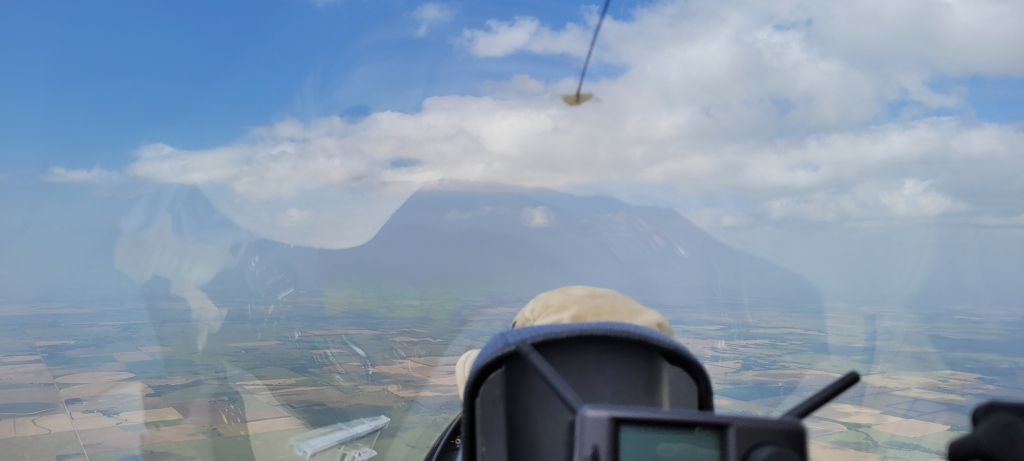
Looking down at the windmills, one side had the wind blowing from the northwest, the other side from the south, and down the middle it was southwest. We were right over the convergence zone, but not in the good air.
I could feel the rudder pedals dancing back and forth. Then I heard from the front,
“Noah is not happy.”
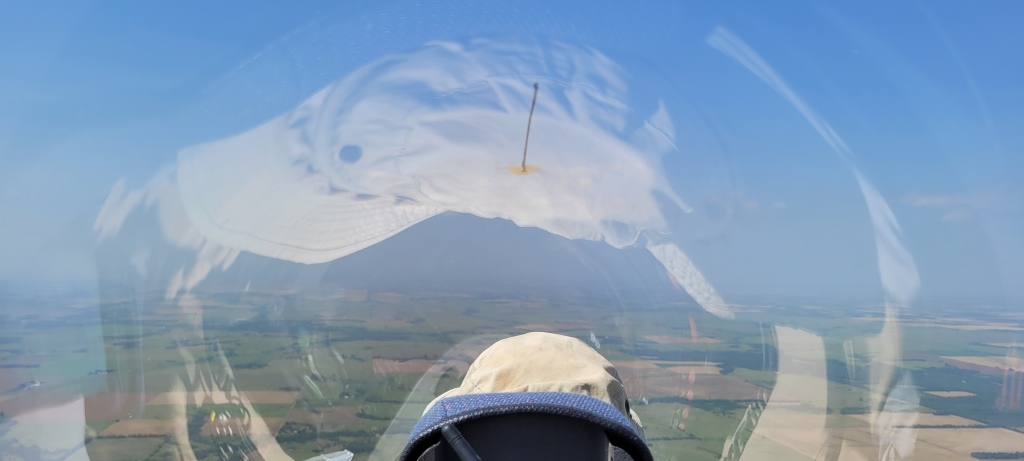
I was anxious too, but it’s an odd feeling being in the back, watching your contest completely unravel in front of you as you rapidly hurdle toward a field short of the finish. It’s almost comical watching the scene as a fly on the wall, having felt it on my own account so many times before. I snapped out of it, cleared my throat, and tried to take a level tone.
“The air looks blue and hazy, but it shouldn’t be dead yet. Keep steady, we should find one out here.”
Down at 3800ft, I saw a vulture.
“Bird! 2 o clock!”
Noah responds,
“Where!? Oh, good visual!
He hauls the glider to the right. Good air, but no thermal quite yet. Five Mississippi, and sure enough we roll into a 2.5 knot thermal in the blue.
I interject,
“Dump the water?”
And Noah responds with Roger and opened the valve.
We climbed up, took in some extra altitude and sailed on home. Looking down, we could see that our main threats were still not there. We knew we had a good day.
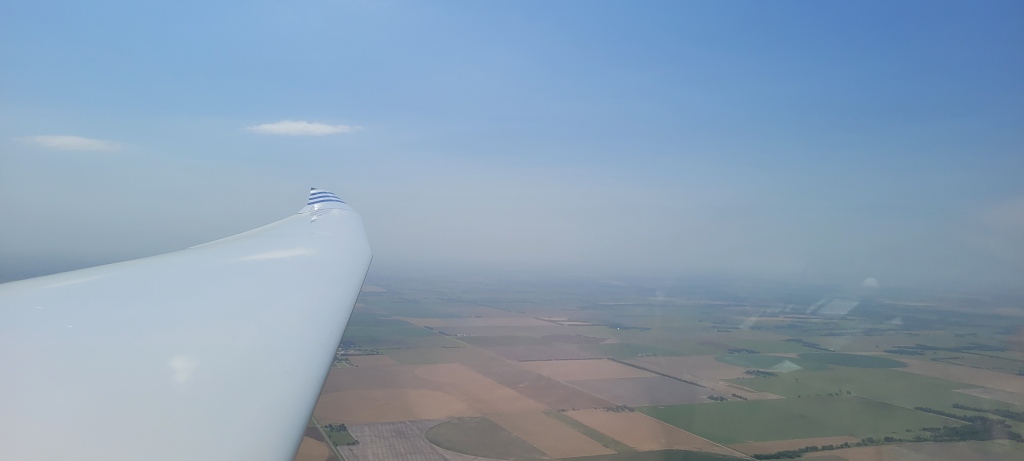
When we landed, we were exhausted. Unlike the second day with its adrenaline rush finish, we sort of hobbled out of the glider, zonked from baking in the sun and being under the pressure knowing that we were walking a tightrope the whole time. We were satisfied we got through and were happy that the several times we rolled the dice today that it went in our favor. This has set us up about 200 points over second place going into the last day of the competition, which is about as good of a place as we can hope for. Here’s to hoping we don’t squander it.
________________________
We thank the Harris Hill club for supporting us at this contest by letting us use their Duo Discus. This glider is an absolute marvel of performance and it has made it possible for us to compete at the highest level among the best pilots in the United States. We really appreciate all the work it takes for clubs to make these opportunities happen.
See race results here.

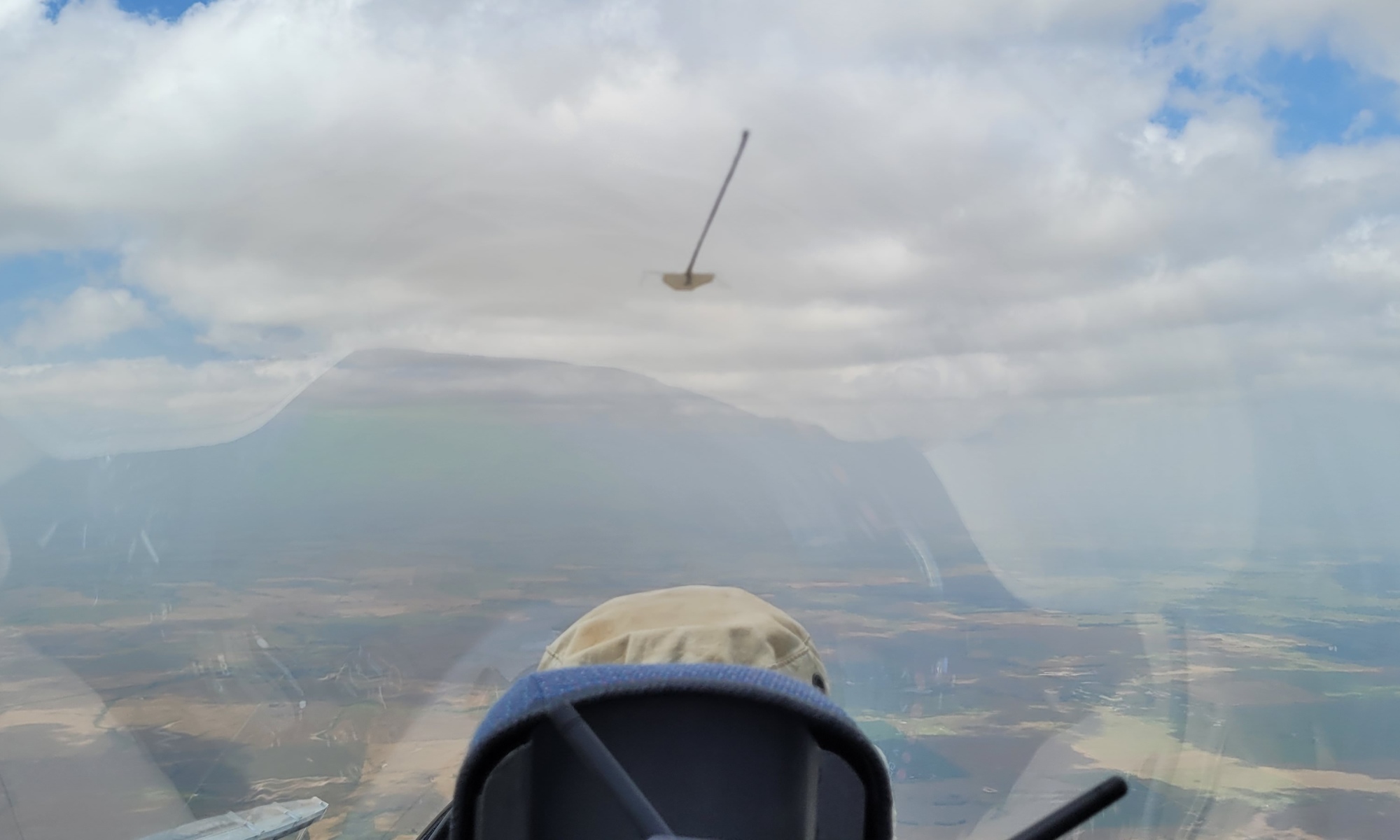
Congratulations Daniel and Noah! You guys rock! Well done on winning another Nationals!
LikeLike